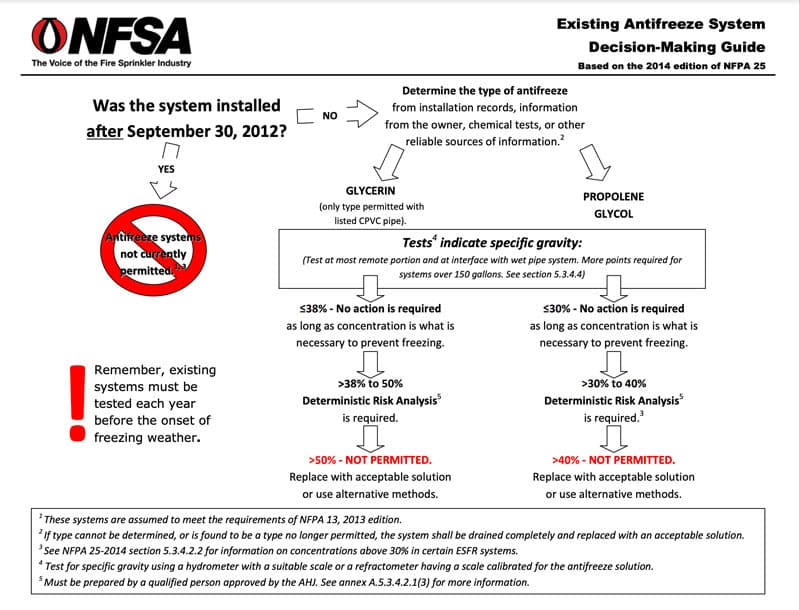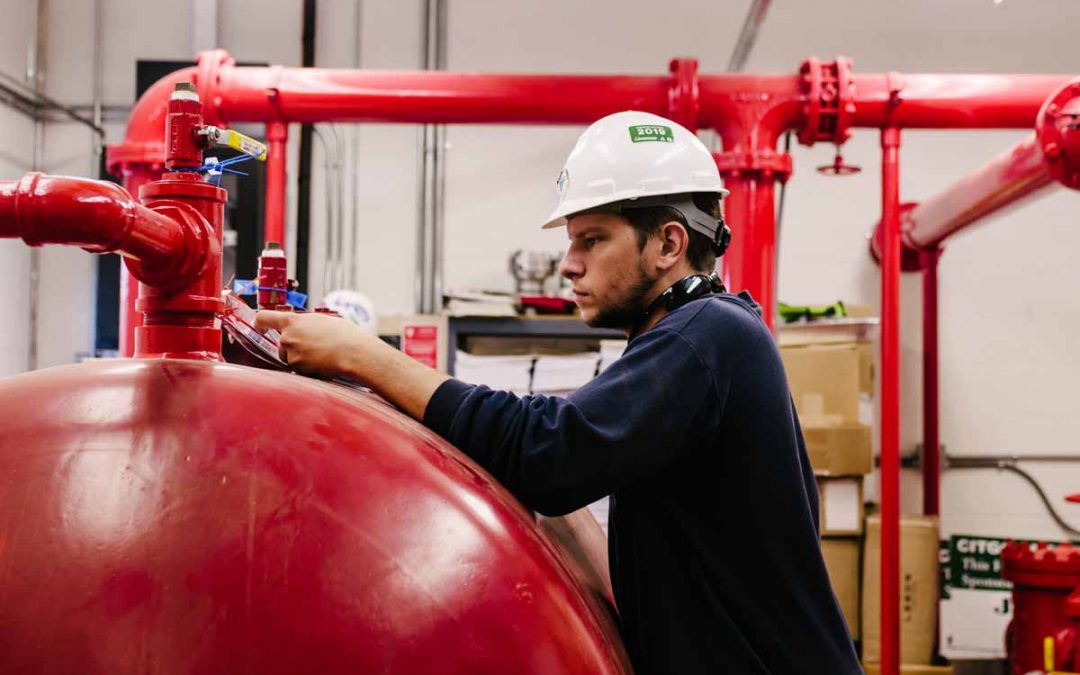NFPA requirements for the use of antifreeze in wet fire sprinkler systems are changing. If you have a wet fire sprinkler system, it’s important to understand what is changing on September 30, 2022, so you can ensure your system is in compliance. This article will break down every component of these requirement changes, so you can understand whether they affect you, how they affect you, and what changes you will need to make to your fire protection system before the September 30, 2022 deadline.
The Use of Antifreeze in Fire Protection Systems: Getting the Rules Straight
Who can use antifreeze in their fire protection systems, who can’t, and why not? Let’s take a closer look at what’s going on here.
Why is antifreeze being phased out of wet sprinkler systems?
A wet fire sprinkler system requires freeze protection if any portion of the sprinkler system is located in spaces where temperatures cannot be maintained at or above 40°F. While antifreeze does a great job of preventing wet fire sprinkler systems from freezing, it also has the potential to make fires worse.
A number of fire incidents have proven that when the proportion of the active ingredients in antifreeze near a sprinkler becomes too high, an antifreeze solution can actually serve as fuel for a fire when the sprinkler discharges. This can cause flash fires or even explosions, putting lives at risk, rather than protecting them.
What are the new NFPA requirements?
In light of this, the National Fire Protection Association (NFPA) conducted a number of studies on freeze protection solutions, and subsequently incorporated changes into the NFPA 13, Standard for the Installation of Sprinkler Systems, and NFPA 25, Standard for the Inspection, Testing, and Maintenance of Water-Based Fire Protection Systems.
You can read the specific directives of each standard at the included links, but for the sake of brevity, we will summarize the actionable components here.

If your wet sprinkler system was installed AFTER 2012
If your fire protection system was installed after 2012, you do not need to take action at this point. Systems installed after 2012 were required to use an antifreeze alternative, but as there were no options yet available on the market, systems installed after 2012 have been designed in a way that antifreeze is not required. Your system should be fine, and does not require changes prior to September 30, 2022.
That said, it’s always good to have your fire protection system inspected and serviced regularly. If you’d like help with routine maintenance or system upgrades, Vanguard Fire & Security Systems is here to help.
If your wet sprinkler system was installed BEFORE 2012
If your sprinkler system was installed before 2012, you were required to make changes to remain in compliance with NFPA 13 and 25 changes made in 2013. You are required to meet annual testing requirements, you may have installed an additional control or test valve, and you were required to install signage explaining the locations of antifreeze, your antifreeze supplier, as well as the concentration and volume of antifreeze in your system.
If these precautions and maintenance requirements sound familiar, you will also need to upgrade your system before September 30, 2022. Let’s talk about what changes you’ll need to make.
What Changes Do I Need to Make to My Wet Sprinkler System Before September 30, 2022?
If your fire protection system was installed prior to 2012, and you still use antifreeze in your system, you must at minimum
- Flush the system. Your fire suppression system will need to be flushed to eliminate any traces of your existing antifreeze solution.
- Replace antifreeze. Once your fire suppression system has been properly flushed, you will need to replace antifreeze with a UL listed, noncombustible, replacement solutions.
Acceptable UL Listed Noncombustible Antifreeze Replacement Solutions
At this time, there are limited replacement solutions on the market. Those accepted solutions are:
- Viking freezemaster™. This UL listed antifreeze solution meets all NFPA requirements for new fire protection systems, as well as existing fire protection systems following that September 30, 2022 deadline.
- Tyco LFP Antifreeze+. This UL listed antifreeze solution also meets all NFPA requirements for systems after the September 2022 deadline, as well as for new fire protection systems.
Both products have passed stringent corrosion tests and are safe for use in cold-weather wet sprinkler systems.
Should I Make Any Other Changes to My Fire Protection System Before September, 2022?
If these updates to NFPA 13 and 25 affect your system, simply replacing antifreeze with a non-combustible solution may not be the only change you need to make. In 2022, your fire protection system will be at least 10 years old, and if it’s been some time since your system was last inspected, it might be time for a few upgrades.
Consider:
- Have you had any inspections done?
- When was the last time your system was serviced?
- Has your facility changed in size in the past 10 years?
- Do you house new or different types of equipment
If it has been some time since your system was last maintenanced, or if your operations have changed since your fire protection system was installed, your wet fire sprinkler system may need some updates. It’s a good idea to have those updates made prior to the 2022 deadline, to ensure your facility is in compliance, but more importantly, to make sure you’re providing a safe environment for your team.
Is a Wet Fire Sprinkler System Still the Best Fire Protection System for your Facility?
If your system is affected by these NFPA code changes, now is a good time to consider if a wet system is still the best option for your facility.
In general, if your system requires antifreeze to keep from freezing over the winter, you are likely better served by a dry or preaction system that is well-suited to colder temperatures. These fire protection systems don’t present the same freeze concern as a wet system, and can protect your facility as well as, if not better than, a wet system.
For more information about dry and pre-action fire suppression systems, check out these blogs:
- What is a Dry Chemical Fire Suppression System
- Clean Agent vs. Pre-Action Fire Suppression Systems
- 3 Types of Fire Sprinkler Systems
Or get in touch with the Vanguard team. Our expert technicians are here to help you get the very best fire protection possible.
The September 30, 2022 deadline is fast approaching. If your system is affected by these code changes, now is a good time to take action. The Vanguard Fire & Security Systems team has the equipment and the experience necessary to help you upgrade your fire protection system to remain in compliance. If you have any questions about what you need to do before 2022, or if you’re interested in making upgrades so you don’t have to worry about that deadline, we can help. Give us a call at 800-444-8719 or contact us online today to request a quote or schedule an appointment.


